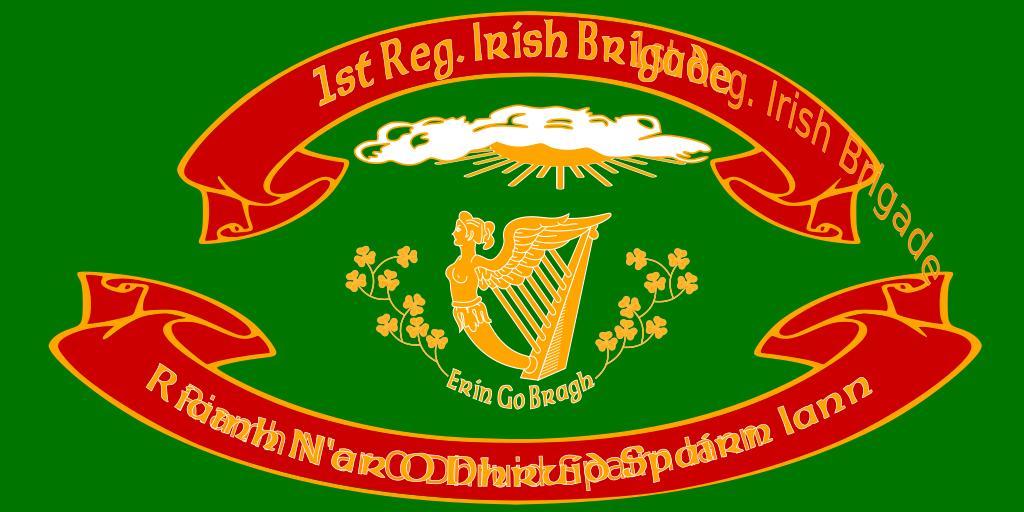MAKE A MEME
View Large Image

| View Original: | Green_Ensign_1st_Regiment.svg (4005x2002) | |||
| Download: | Original | Medium | Small | Thumb |
| Courtesy of: | commons.wikimedia.org | More Like This | ||
| Keywords: Green Ensign 1st Regiment.svg 69th New York State Volunteer Infantry Ist Regiment Irish Brigade The Sixty-Ninth New York State Volunteer Regiment Company A first served the United States in the American Revolution and the War of 1812 while the remainder of the Regiment has its origins in early 1851 when the Irish citizens of New York City formed a militia regiment known locally as the Second Regiment of Irish Volunteers On October 12 1851 the unit was officially accepted as part of the New York State Militia and designated as the Sixty-Ninth Regiment When President Abraham Lincoln made his first call for volunteers following the bombardment of Fort Sumter the 69th NYSM New York State Militia was the second unit to leave New York City The 69th NYSM fought at the First Battle of Bull Run under General William T Sherman and served with distinction as the rear guard of the Federal withdrawal During its defense of the Union retreat the commanding officer of the 69th NYSM Colonel Michael Corcoran was captured by Confederate forces Because it was organized as a ninety-day unit the 69th NYSM returned to New York after the First Battle of Bull Run to muster out of Federal service The regiment was then reformed as two separate Volunteer Regiments of which one the 69th New York State Volunteers NYSV became the nucleus of the Irish Brigade and was joined by two other predominantly Irish regiments the 63rd and 88th New York A second regiment the 69th New York National Guard NYNG was also organized from the original 69th NYSM and formed the nucleus of the Irish Legion under the command of General Michael Corcoran who had been freed from a Confederate prison in Virginia The Irish Brigade was placed under the command of General Thomas Francis Meagher a man of outspoken anti-English sentiments who had been exiled to Tasmania by the British Crown for his activities on behalf of Irish independence Beginning with the ill-fated Peninsula Campaign the Irish Brigade and the 69th NYSV in particular built a reputation for hard fighting on the field of battle and lavish hospitality in its camp As part of the renowned Second Corps the Irish Brigade figured in many advances and rear-guard actions and more than one Union general was known to ask Where are my green flags In addition to these accolades the 69th NYSV received it legendary nickname from another famous general After hearing that the 69th NYSV faced him across the field during one of the Seven Days battles General Robert E Lee himself remarked Ah yes that Fighting 69th The Irish Brigade passed through its most valorous period between the Battle of Antietam September 17 1862 and the Battle of Gettysburg July 1 - 3 1863 This series of events saw the 69th NYSV from its frontal assault on the Sunken Road at Antietam to the disastrous charge of Mayre's Heights at Fredricksburg to its battle in the Wheat Field at Gettysburg The Irish Brigade remained with the Army of the Potomac under the command of General Ulysses S Grant fighting in every major engagement until the surrender ceremony at Appomattox By the end of the Civil War the 69th NYSV had served with distinction in every major campaign of the Eastern Theater from Bull Run to Appomattox and was noted for the length of its service and the number of engagements in which it participated Of the two thousand regiments that comprised the Union Army the 69th NYSV ranked sixth in losses and led all regiments from New York State Through the blood and sacrifice of these brave men the United States their native or adopted homeland was preserved http //www bly-mazaska-nashaba de to/fahnen-der-freiwilligen-regimenter-der-union_64505372 html/ / or US Government inkscape September 1861 - July 1865 William Tecumseh Sherman US Government PD-USGov This flag is different from the original versions Category Green red white yellow flags Flags of New York Flags of the American Civil War Flags with mottos Green harp flag Infantry flags of the United States Army Inscribed flags names Military in New York New York in the American Civil War SVG flags - military of the United States Michael Corcoran | ||||